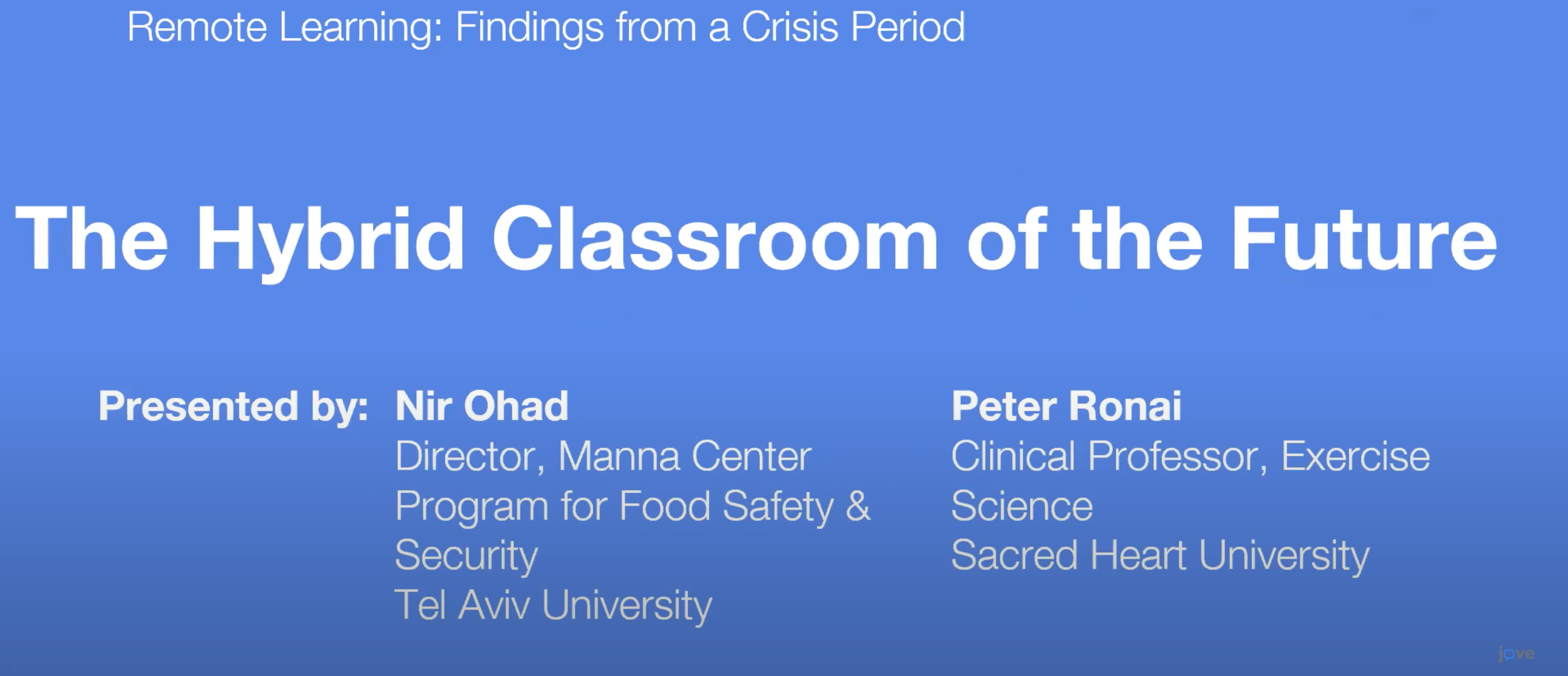When COVID-19 struck earlier this year, Prof. Peter Ronai (Clinical Professor of Exercise Science at Sacred Heart University) and Dr. Nir Ohad (Director of the Manna Center Program for Food Safety & Security at Tel Aviv University) both looked to the hybrid model of instruction.

Professor Peter Ronai
Peter, at the time, was teaching upper-level courses in exercise testing and functional anatomy, which he ‘flipped’ — he provided students with plenty of background material to get them engaged and ready to learn, and they met in the classroom to learn crucial hands-on skills. By doing this, he noted, “Students were ready to perform and to do all the skills with a minimal amount of extra discussion and extra explanations” — this was critical, given that COVID-19 precautionary measures had led to reduced in-lab class time.

Dr. Nir Ohad
Nir, on the other hand, used a fully online approach in his introductory biology course, combining synchronous and asynchronous learning. He and his team had students watch videos and pre-recorded lectures in their own time, and they used Zoom sessions to review material and answer students’ questions. This procedure, he notes, allowed students to get a much better grip on the material.
In both Peter and Nir’s newly hybrid classrooms, students showed excellent learning outcomes, rivaling student performance in the same courses in previous years. During our remote learning webinar series, they discussed key takeaways from their experience of developing hybrid science courses. Here are five of their top tips.
If you would like access to a full video recording of Peter Ronai and Nir Ohad’s webinar, let us know here.
1. If you’re using video, ensure that it's the right length
Both Nir and Peter note that when it comes to video — be it pre-recorded lectures or other types of video content — shorter is better. “If you’re getting over 2 to 2.5 minutes, you’re better off breaking your videos into smaller pieces and scattering them throughout the lesson because most students are not going to stay on for much longer than that,” said Peter.
Nir also made sure to break up his pre-recorded lectures into several sections. In addition to allowing him to expand upon individual sections in the future by adding more video content, shorter sections proved to be much more engaging for students. “We should divide the content into short blocks to help and ease the students for understanding and going over the material,” he recommends — a helpful tip he attributes to Prof. Motti Neiger’s 10 rules of thumb for teaching remotely.
2. Use a wide variety of visual material in diverse ways
Visual material formed a substantial portion of the resources assigned by both professors. Nir pre-recorded his lectures and also employed plenty of short video demonstrations. For instance, he used a tube and a glass of water to demonstrate the processes of cohesion and adhesion in one of his recorded lectures.
Peter used a variety of descriptive animations, pictures and video clips of students performing essential clinical skills, as well as JoVE Science Education: Clinical Skills videos. “The range of motion measurements, the manual muscle testing, heart rates, blood pressure, peripheral pulse assessments…the videos are excellent for that,” noted Peter.
Peter recommends that in addition to class discussions, descriptive animations, video clips and images should also be embedded in lab manuals and presentation slides. This allows students to easily access and watch techniques that they’re learning about. “The students like that and can relate to it,” he says.
3. Generate dialogue with your students
“We need to generate a dialogue with the students, to listen to their needs and to address them,” said Nir. This was especially pressing in his first-year course; many students were still struggling with transitioning from high school to university. Nir and his team developed a new model for mentoring students to address this challenge. Every faculty member in his department personally mentored five students — they would frequently call and write to them, check in on them, and provide support. They also set up chat rooms for groups of students on Moodle, which students could use to interact easily with teaching assistants.
For Peter, setting strategic assignments helped him better understand which students he needed to reach out to. He notes that their performance in numerous assessments through the semester proved to be a ‘litmus test’ for determining which students required additional support.
4. Use assessments to increase student engagement in virtual lectures
How can instructors ensure that students are engaged during virtual lectures? Nir suggests adding short quizzes after the lecture or embedding the questionnaires within the pre-recorded video. Peter also suggests creating short quizzes that students would find hard to answer if they were not engaged during the lecture. Telling students about these assessments ahead of time is valuable, notes Peter, “so they already have a vested interest when they’re coming to class.”
Peter also increases student engagement by assigning videos and case studies that students must think about critically. For instance, during the lecture, he might play a video of someone undergoing a movement assessment; students have to watch it, determine what is or isn’t wrong, and what exercise selections they might make. He also presents patient-oriented case studies, giving students facts about a hypothetical client before class and having them come up with real-world solutions. Presenting such scenarios allows students “to better connect the theory with real practice,” he notes.
5. Give students time to adapt
Nir emphasizes that lighter workloads earlier in the semester can help give students time to adapt, and the workload should be increased gradually over the term. Peter suggests that early in the semester, instructors can develop activities that allow students to capitalize on their skills. For instance, students could develop creative projects relevant to their course using Zoom, chat rooms or technologies they enjoy working with.
At the end of the day, every approach to hybrid learning should be informed by the needs of the learners in the course. “Fit the methodology to the students,” recommends Nir.
To learn more about Nir and Peter’s approach to building hybrid courses — including virtual labs — and many more insightful takeaways from their experience, request a video recording of their session here.

